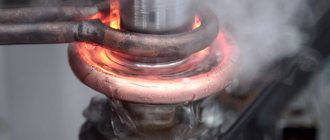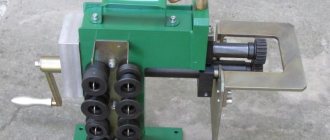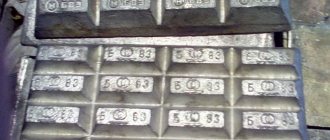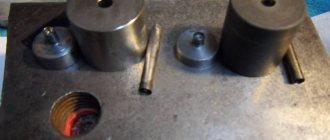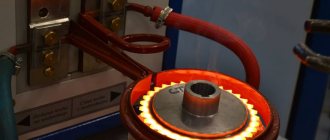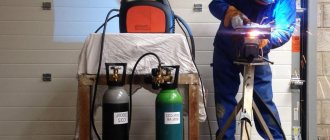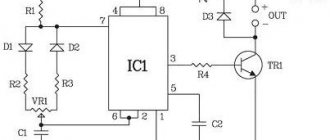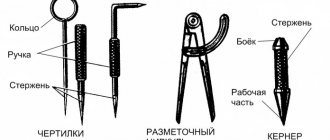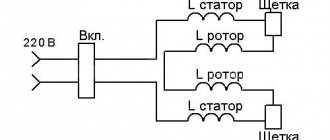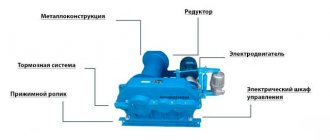Everyone had to observe spark discharges, including people who were far from knowledge of electrical engineering. Thunderstorms are accompanied by giant spark discharges. The release of enormous energy concentrated in the electrical discharge of lightning (see Fig. 1) is accompanied by a blinding flash of a hot barrel. One of the types of spark discharges created by humanity is an arc discharge, or simply, an electric arc.
Rice. 1. Lightning discharge
To date, the reasons for the occurrence and properties of an electric arc have been studied in detail by science. Physicists have found that in the area of its combustion there is a huge concentration of charges that form the plasma of the barrel. The temperature of the column reaches several thousand degrees.
What is an electric arc?
This mysterious phenomenon was first described by the Russian scientist V. Petrov. He created an electric arc using a battery consisting of thousands of copper and zinc plates. Studying the process of igniting an arc with direct current, the scientist came to the conclusion that the air gap between the electrodes under certain conditions becomes electrically conductive.
One of the conditions for the occurrence of electrical breakdown is a sufficiently high potential difference at the ends of the electrodes. The higher the voltage, the larger the gas gap the discharge can bridge. In this case, an electrically conductive gas column is formed, which becomes very hot during the burning of the arc.
Rice. 2. Electric arc
A reasonable question arises : “Why does air, which is an excellent insulator in its normal state, suddenly become a conductor?”
There can be only one explanation - charge carriers are formed in the arc barrel, capable of moving under the influence of an electric field. Since there are no free electrons in air, unlike metals, only one conclusion suggests itself - ionization of gases (see Fig. 3). That is, starting the process of gas saturation with ions that are carriers of electric charge.
Rice. 3. Physics of the electric arc
Air ionization occurs under the influence of various types of radiation, including X-ray and cosmic irradiation. Therefore, there are always small amounts of ions in the air. But since the ions almost immediately recombine (turn into neutral atoms and molecules), the concentration of charged particles is always tiny. It is impossible to produce an arc flash at such a concentration.
For an arc discharge to occur, an avalanche-like ionization process is required. It can be caused by the strong heating of the gas that occurs during ignition.
When the contacts open, electrons are emitted and accumulate in a very small space. Under the influence of electric field strength, negative charges rush towards the electrode with a positive sign.
When the breakdown voltage is reached, a spark discharge occurs between the electrodes, heating the area between the electrodes. If the current is large enough, then the amount of heat will be sufficient to trigger an avalanche-like process of air ionization.
In an area called the arc gap, a barrel is formed, called an arc column, consisting of hot conductive plasma. A current flows through this barrel, maintaining the heating of the plasma. This is how the arc discharge ignites.
Saturation of the plasma barrel with ions of different signs leads to a significant increase in the current density, as well as to the recombination of some of the ions. Warming up the plasma also leads to an increase in pressure in the barrel. Therefore, some of the ions escape into the surrounding space.
If the formation of new charges is not maintained, the arc will be extinguished. As we have already found out, stable combustion is accompanied by 2 factors: the presence of voltage between the electrodes and maintaining a high plasma temperature. Excluding one of them will lead to arc extinguishing.
Thus, we can formulate the definition of an electric arc . Namely, an electric arc is a type of spark discharge, accompanied by a high current density, burning duration, and a small voltage drop across the barrel, characterized by increased gas pressure in which a high temperature is maintained.
An electric arc differs from a conventional discharge in that it burns longer.
Varieties
There are several classifications of the element in question, which have different current supply schemes and the environment where it appears.
Arc welding is divided into the following types:
- With direct action. In this case, the equipment is installed parallel to the metal product that needs to be welded. The arc, in turn, becomes at right angles towards the electrodes and the metal surface.
- With indirect action. Appears when using two electrodes that are located at an angle of 50 degrees from the work being welded. An arc appears between the electrode and the material being welded.
The appearance of a welding arc.
In addition, it can be divided according to the principle of the atmosphere where the welding arc appears:
- Open sphere. The arc can burn in an open space with the formation of a gas phase, which contains vapor of the metal, electrode and surfaces after processing with a welding tool.
- Closed sphere. The arc burns under flux. In the gas phase near the arc, vapor from the material, electrodes and the flux layer itself enters.
- With supply of gas mixture. The arc may contain compressed gas such as helium, carbon dioxide, hydrogen, argon and other gaseous impurities. They are necessary so that the welded surface of the product is not subject to oxidation. Thanks to their supply, the environment is restored or becomes neutral to external factors. The gas supplied for operation, steam from the product being welded and the electrodes enter the arc.
In addition to the listed classifications, we can also distinguish types by duration of action:
- classic is used for constant use;
- pulse – for one-time use.
You can also distinguish varieties depending on the material of the electrode used - carbon, tungsten, consumable or non-consumable electrode, respectively.
One of the most popular parts is steel, i.e. consumable electrode. However, today most professionals prefer non-melting, from which we can conclude that the types of elements under consideration are quite different from each other.
Structure
The electric arc consists of three main zones:
- cathode;
- anodic;
- plasma column.
In welding arcs, the dimensions of the cathode and anode zones are small compared to the length of the column. The thickness of these zones is thousandths of a millimeter. In the area of the cathode voltage drop (at the end of the negative electrode), the presence of cathode spots is observed, which are formed as a result of strong heating.
Figure 4 shows a diagram of the structure of the arc created by the welding machine.
Rice. 4. Welding arc structure
Please note: for the purpose of clarity, the electrode zones are greatly exaggerated in the picture. In reality, their thickness is measured in microns.
Possible problems
During treatment, various problems may arise associated with breakage and deformation of braces:
- During the period of adaptation to the system, individual elements and edges of the arch sometimes rub the mucous membrane of the tongue, gums, and the inner surface of the cheeks and lips. To prevent this complication and eliminate it, orthodontists recommend using a special wax that covers the structure, forming a protective barrier between the braces and soft tissues. If abrasions and irritation have already appeared, you need to rinse your mouth with antiseptic solutions or decoctions of anti-inflammatory herbs.
- The wire begins to lengthen as the teeth move and may begin to dig into the lining of the gums and cheeks. If this happens, there is no need to endure discomfort; it is important to visit an orthodontist to correct the protruding structural elements.
- Part of the arch may fall out or come out of the grooves of the braces as a result of vigorous brushing of the teeth or eating rough food. Sometimes the situation can be corrected using tweezers, with which a piece of wire is simply inserted into the groove of the system, but this action cannot always be performed independently. An orthodontist will help you cope with the problem that has arisen; the main thing is to contact him immediately, since an incorrectly fixed structure will negate the effect of treatment.
- Braces can break due to high chewing loads, maxillofacial trauma to the patient, or poor quality material. In such a situation, arcs are often changed unscheduled. If the wire breaks, you need to make sure that its particles do not get into the human esophagus, since the sharp edges of the wire can damage the surface of the gastrointestinal mucosa.
Useful Application
Oddly enough, physicists found application for this electrical phenomenon even at the stage of development of the science of electricity. An example of this is the Yablochkov light bulb . It consisted of two carbon electrodes, between which an electric arc was ignited.
This lamp had two drawbacks. The electrodes quickly wore out (burned out), and the light spectrum shifted to the ultraviolet zone, which negatively affected vision. For these reasons, arc lamps did not find widespread use and were quickly replaced by incandescent lamps, which exist to this day.
The exception is arc-discharge lamps, as well as high-power spotlights used primarily for military purposes. The arc discharge has been widely used in practice since the invention of the welding machine. Arc welding is used for welding metals. (see Fig. 5)
Rice. 5. Arc welding
Using plasma conductivity, including special welding electrodes in the welding circuit, a high temperature is achieved in a concentrated spot. By adjusting the welding current, the welder has the opportunity to adjust the machine to the desired temperature of the arc discharge. To protect the barrel from heat loss, the metal electrodes are coated with a special mixture that ensures combustion stability.
An electric arc is used in blast furnaces for melting metals. Arc melting is convenient in that you can regulate its temperature by changing the current parameters.
Along with useful applications, in electrical engineering we often have to deal with arc discharges. An uncontrolled arc discharge can cause significant damage on power lines, industrial and domestic networks.
Rice. 6. Arc discharge on power lines
Application of chord and height
There is a method for calculating the length of an arc along the chord and the height of the perpendicular. It is called the Huygens formula. A chord is a part of a straight line located inside a circle. The chord passing through the center is called the diameter.
Huygens' formula is used if the central angle is less than 60 degrees. To carry out calculations, you must first connect the points of the circle with a straight line. This will be a chord. Next, you need to draw a perpendicular from its middle, and from the point of contact of the perpendicular with the arc, draw two straight lines to the ends of the chord.
The result is an isosceles triangle, the sides of which will be denoted by l, and the chord itself will be called L. For angles greater than 60 degrees, Huygens' formula should not be used, since an error may occur in the calculations. The larger the angle, the greater the error will be.
By measuring the chords L and l, you can obtain the value of the arc indicated in blue in the figure. If L is 30 mm and l is 20 mm, then P = 2 * 20 + 3.33 = 43.33 mm.
Now that you have an understanding of the calculation methodology, you can use an online calculator. This tool is good for checking the result obtained experimentally, especially when processing a large amount of data when you need to quickly get an answer.
The online calculator allows you to save the obtained values in the computer's buffer memory. Arranging data in the form of an arbitrary table or graph in a coordinate system is not difficult. The length of the arc of a circle according to the online calculator is calculated using any of two formulas: either by degrees, or by chord and height . Figuratively speaking, these formulas are synonyms, they are interchangeable.
Causes
Based on the definition, we can name the conditions for the occurrence of an electric arc:
- the presence of multipolar electrodes with high currents;
- creation of a spark discharge;
- maintaining voltage on the electrodes;
- providing conditions for maintaining the temperature of the barrel.
A spark discharge occurs in two cases: during short-term contact of the electrodes or when approaching breakdown parameters. A powerful electrical breakdown always ignites the barrel.
While maintaining the optimal arc length, the plasma temperature is maintained independently. However, as the gap between the electrodes increases, intense heat exchange occurs between the barrel and the surrounding air. Eventually, in the barrel, due to a drop in temperature, the formation of ions will stop like an avalanche, resulting in the extinguishing of the flame.
Breakdowns often occur on high-voltage power lines. They can lead to the destruction of insulators and other negative consequences. A long electric arc goes out quite quickly, but even in a short burning time its destructive power is enormous.
An arc tends to form when contacts open. In this case, the switch contacts quickly burn out, the electrical circuit remains closed until the barrel disappears. This is dangerous not only for networks, but also for humans.
Degree measure
The length of the arc between points on the circle is a function of the central angle formed by the radii of the circle (see figure) in direct proportion. This is what the degree measure is based on.
A part of a circle is taken as 1° of arc.
Since L is equal, then the rotated angle of 180° will correspond to the arc length.
If the angle value is 1°, the formula looks like this: .
Therefore, the formula for the length of a circular arc with a central angle n° will be expressed as follows: .
Let's determine the value of l for an angle of 120° with a radius of 5 mm: l=3.14*30*5/180=2.62 mm.
Extinguishing methods
It should be noted that arc extinction occurs for various reasons. For example, as a result of cooling of the column, a voltage drop, or when the air between the electrodes is displaced by external vapors that prevent ionization.
In order to prevent the formation of arcs on high-voltage power line wires, they are spaced over a long distance, which eliminates the possibility of breakdown. If a breakdown between the wires does occur, the long barrel will quickly cool and extinguishment will occur.
To cool the barrel, it is sometimes divided into several components. This principle is often used in the designs of air circuit breakers designed for voltages up to 1 kV.
Some circuit breaker models contain multiple arc chutes to promote rapid cooling.
Rapid ionization can be achieved by evaporating certain materials surrounding the space of the moving knives. High-pressure evaporation blows away the plasma of the barrel, resulting in extinguishing.
There are other methods: placing contacts in oil, auto-blowing, using electromagnetic damping, etc.
Practice with problems
It is necessary to say a few words about the study of geometry in the middle classes of secondary schools. There is a category of students for whom formulas are difficult to understand. Such students need visual material.
In a geometry lesson, when studying material on calculating the parameters of a circle, you can conduct a practical lesson. To do this, you should first prepare: make a small drawing-projection of a gymnastic ring. The purpose of the lesson is to learn how to use formulas in the process of work. During the classes:
- Ask the student on duty to bring a gymnastics ring (hula hoop) of small diameter from the gym.
- Mark 3 dots on the outside of the ring with a felt-tip pen or colored chalk. After this, it will be divided into several sectors.
- Make a projection of the ring on the blackboard with dots marked. On the drawing, mark the center of the circle and draw the diameter. Then you need to connect the points marked on the circle with radii to the center of the circle and chords to each other.
- Take all measurements. Obtain the values of all parameters and write them on the board. It is first divided into two parts: in the center, accessible for viewing, there will be the values of the central angles AOB and BOC, the diameter, and the length of straight lines AB, BC and AC.
- Write down the answers (the desired values) on the right side of the board and cover them with a curtain until the end of the practical lesson.
Next, divide the class into 4 small groups. Each of them needs to be given a task to carry out calculations using the studied formulas .
- group No. 1 calculates the length of the arc between points A and B, using the degree measure of the central angle AOB;
- the second group receives a similar task for the segment between points B and C;
- the third group calculates the desired parameter between points A and C, using the length of the chord AC and auxiliary lines AB and BC;
- Group No. 4 works with points A and C, using the AOC angle values.
You have 12 minutes to complete the task. After the time has expired, a student comes out from each of the four groups, explains the formula and writes the result on the board. These answers are compared with ready-made measurements written down earlier on the right side of the board.
The next 7 minutes of the lesson are devoted to discussing the result obtained and analyzing the occurrence of error.
Exposure to humans and electrical equipment
An electric arc poses a danger to humans due to its thermal effects, as well as the ultraviolet effect of the emitting light. High AC voltage poses a huge danger. If an unprotected person is at a critically close distance from live parts of devices, an electrical breakdown may occur with the formation of an arc. Then, in addition to the effect of current, the body will be affected by a thermal component.
The spread of an arc discharge through structural parts of equipment threatens to burn out electronic elements, boards and connections.
What are arcs used for and how do they work?
It is impossible to correct the bite or misalignment of a person’s teeth by simply gluing braces to the surface of the enamel. Without an orthodontic arch, the structure will not work. It is made of flexible but very strong metal wire having different cross-sections.
On a note!
The alloys that are used as the basis for the arcs have shape memory, which means that they can return to their original state regardless of what shape they are subsequently given. It is this feature that makes arches effective in correcting bites.
When creating braces, the orthodontic arch is shaped using special equipment to form the correct position of the dentition. During the process of fixing the system, the arc is inserted into the grooves of the plates and fixed with ligatures or locking mechanisms when choosing a self-ligating design. During treatment, the arch will begin to strive to take the initially given position of the correct dentition, moving the teeth along with it. Thanks to this, existing malocclusions are eliminated.
How much does it cost to replace an archwire on a bracket system?
All brace systems require individual adjustments, tensioning and arch replacement. The cost of replacing a vestibular element in clinics in Moscow and St. Petersburg averages from 2,000 rubles, and a lingual element from 3,500 rubles. If the structure breaks down, the price for repairs, installation and activation of the leveling wire is calculated individually.
The cost of the procedure can be influenced by the system manufacturer:
- replacement of the arc with Ormco – 2500 rubles;
- replacement with 3M Unitec structures - 2800 rubles;
- replacement with American Orthodontics braces - 2900 rubles.
Relative position of two circles
Concentric and eccentric circles.
Two circles are called concentric when they have one common center, and eccentric when their centers do not coincide.
Drawing 96 shows concentric circles and drawings 97, 98, 99, 100 and 101 show eccentric circles.
Outer and inner circles
.
Circles are called external when all points of one lie outside the area of another circle, and internal when all points of one lie inside the area of another circle.
Drawings 97 and 99 show outer circles, drawings 96, 98 and 100 show inner circles.
Tangent circles
.
Circles are called tangent when they have one common point.
The common point of two tangent circles is called their point of contact.
Contact is called external when two circles, having a common point, lie one outside the other, and internal when one circle lies inside the other. Fuck it. 99 we have the case of external, and in drawing 100 the case of internal contact.
Intersecting circles
. Circles are called intersecting when they have two common points (Fig. 101).
The center line is a segment connecting the centers of two circles.
Theorem 71. Two circles that have a common point on the line of centers cannot have another common point.
Given. Two circles with centers O and O' have a common point A (Fig. 102).
It is required to prove that they have no other common point.
Proof. Suppose there is another common point B, therefore,
OB = OA and O'B = O'A.
Adding these equalities, we would have
OB + O'B = OA + O'A or OB + O'B = OO'
the equality is inconsistent, because a broken line cannot be equal to a straight line.
So, there cannot be another common point (CHT).
Theorem 72. Two circles that have one common point outside the line of centers have another common point on the other side of the line of centers.
Given. Two circles (Fig. 103) connecting the centers.
It is required to prove that there is another common point on the other side of the centers.
Proof. From point A we lower the perpendicular AG to the line of centers and, as its extension, we lay out a segment BG equal to AG.
Let us prove that point B will be another common point. Point B lies on circle O, for AO = BO as equal obliques located at equal distances AG and BG from the perpendicular OO'. Point B lies on the circle O', because AO' = BO' as equal obliques located at equal distances AG and BG from the perpendicular OO', therefore, point B is another common point (CP).
Theorem 73. If two circles intersect at two points, then the line of centers is perpendicular and bisects the chord connecting the points of intersection.
Given. Points A and B are the intersection points (Fig. 104) of two circles.
We need to prove that AG = BG and AB ⊥ OO'.
Proof. Triangles OAO' and OBO' are equal, because OO' has a common side.
OA = OB as the radii of the circle O.
O'A = O'B as the radii of the circle O'.
Hence,
∠AOO' = ∠BOO'
Triangles AOG and BOG are equal, because OG side is common, AO = BO as radii, ∠AOG = ∠BOG as proven. Therefore, AG = BG (chord AB is bisected by the line of centers), ∠AGO = ∠BGO (chord AB is perpendicular to the line of centers).
Thus, the chord AB is bisected and perpendicular to the line < AO + AO'
with another
AO + OO' > AO'
hence,
OO' > AO' - AO
2. If two circles touch, the distance of the centers is equal to the sum of the radii if the contact is external, and the difference of the radii if the contact is internal.
From drawing 105 it can be seen that
OO' = AO + AO'
and from drawing 106
OO' = AO - AO'.
3. If one circle lies outside the other, the distance of the centers is greater than the sum of the radii.
From drawing 107 it can be seen that
OO' > AO + BO'
4. If a circle lies one inside the other, the distance of the centers is less than the difference of the radii.
Indeed, from drawing 108 it is clear that
OO' < AO - BO'.
It is important to change the arc on time
At each stage of treatment you need to get a certain result. Once it is reached and the teeth have assumed their new position, the archwire no longer works. And if you often postpone doctor's appointments, each week of delay prolongs the entire treatment.
Wearing one archwire for too long does not harm your teeth, but it does not make sense.
Treatment by an orthodontist requires self-discipline. Be prepared to adjust your schedule around your doctor's appointments. And remember that all this is done for the sake of health and a beautiful smile. And this is the best incentive!
